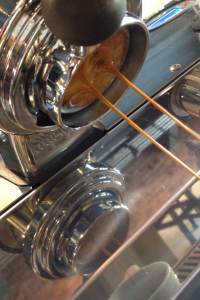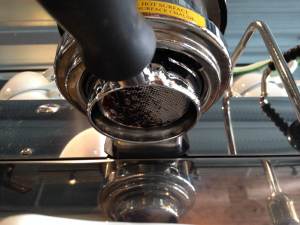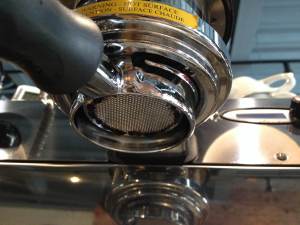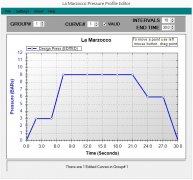Common extraction problems in the production of espresso Starbucks espresso often makes mistakes

Professional barista communication, please pay attention to coffee workshop (Weixin Official Accounts cafe_style)
The extraction problem of Italian concentration was mentioned in the previous part. The following are more common examples:
Over-extraction-
First of all, you must understand the concept of extraction rate, according to VST Coffee Refractometer.(Coffee refractometer, official measurement instrument for many international coffee competitions) Measurement standard, reasonable coffee extraction rate (extraction yield) between 18% and 21%, of course there are coffee people (e.g. Matt Perger) Pursue an extraction rate slightly higher than 21%, but in general, if the actual extraction rate exceeds the ideal extraction rate of this coffee bean, that is, the problem of over-extraction occurs. The roasting degree, variety and condition of each coffee bean are different. The same extraction rate may be suitable for light roasted Kenya SL-28, but medium roasted Brazil Bourbon, light medium roasted Bolivia Typica or a certain formula bean is not applicable. Excessive extraction often has coffee liquid and grease (Crema) black phenomenon, sometimes produce obvious large bubbles floating on the liquid surface, usually extraction time is too long (such as: more than 1 minute), and more than 10 seconds to see the first drop of coffee liquid. There are many reasons for over-extraction, common are: coffee powder grinding too fine, water temperature is too high, extraction pressure is too high, filling pressure is too strong, etc., taste often with bitter, astringent feeling.
Under-extraction-
In contrast to over-extraction, under-extraction usually means that there are still many unextracted aromatic molecules in the coffee powder, but the default extraction time has expired, that is, the extraction rate is generally known to be less than 18%. Under extraction coffee liquid may have a lighter yellow color and lack of coffee oil, usually extraction time is too short (e.g.: 15 seconds to complete extraction), coffee in the pressure like a large amount of water flow out, and not normal extraction like honey flow down the sticky feeling, the above phenomena are insufficient extraction symptoms. There are many reasons for insufficient extraction, such as: coffee powder grinding too coarse, water temperature is too low, extraction pressure is insufficient, filling pressure is too light, etc., taste often with strong and sharp fruit acid, salty, water feeling and lack of due sweet feeling.
Uneven Extraction-
Uneven extraction is usually a combination of over-extraction and uneven extraction, the more common are: channeling effect (Channeling), side channeling effect (Side Channeling), Donut Extraction (or called Edge Channeling outer ring channel effect), etc.
The channel effect occurs at a certain point or block at the bottom of the filter cup, and it is difficult for water to pass through. There may be many reasons for this, such as the inclusion of new and old powder after adjusting the scale of the bean grinder, powder dropping and powder distribution.(Distribution) uneven, coffee powder agglomeration, etc., if the use of bottomless handle can be seen in the early stage of extraction of the block is black and no liquid flow, sometimes because the pressure is too large, water can pass through the range is very small and there are water jets out, this phenomenon on the flavor of the impact can be large or small, depending on the scope and extent of the channel effect, the greater the degree will produce bitter, astringent and other defective flavor.

(There is a small area of channel effect in the center of the filter cup in the photo, which causes it to be darker and blocked)
Side channel effect is a very serious channel effect, usually because of the pressure (Tamping) when the force left and right or before and after uneven caused, may also be due to the brewing head of the water flow bias caused, observe the extraction will find that one side of the coffee flow too fast, while the coffee flow too slow, the presentation of the flavor is usually very bad, all kinds of defects may be concentrated in this cup, such as bitter, dry, sharp acid, salty and so on.

(Side channel effect in photo, coffee flows out first from left side)
Doughnut extraction is usually a phenomenon that the outer ring extraction is faster and the central extraction is obviously too slow. Like the side channel effect, it usually produces various defective flavors. If it is not very serious, this phenomenon disappears after about 15 seconds of extraction, but do not think that the next coffee liquid column (Stream) seems to be normal extraction. There is not much problem, because when the extraction is in the middle, the coffee liquid in the outer ring has begun to increase and concentrate in the center. Therefore, it is impossible to observe the extraction difference between the center and the outer ring, but in fact, the uneven extraction is still ongoing, so don't be fooled by the appearance. This problem is usually caused by the fact that the coffee powder is more compact in the center and looser in the outer ring after filling, or the filter cup itself is of poor quality and the bottom is not flat. Curve) can sometimes improve such problems.

(Donut extraction in photo, coffee flowing out first from outer ring)
Important Notice :
前街咖啡 FrontStreet Coffee has moved to new addredd:
FrontStreet Coffee Address: 315,Donghua East Road,GuangZhou
Tel:020 38364473
- Prev

The extraction standard of espresso the traditional Italian formula and the different deduction of the extraction standard by SCAA
Communication of professional baristas Please pay attention to the coffee workshop (Wechat official account cafe_style) Italian concentrated extraction judgment plays an important role in a coffee shop that pays attention to coffee quality, because Italian concentrate is not like coffee brewed by hand, French filter pot, or siphon (Saifeng kettle). After brewing, you can take a sip to confirm the flavor and quality of the coffee.
- Next

Variable pressure! Pressure curve Pressure Profiling of pressure swing extraction of espresso
For the exchange of professional baristas, please pay attention to the coffee workshop (Wechat official account cafe_style) Pressure Profiling, or Pressure Profile (s) (pressure curve), which was invented with the progress of Italian coffee machine manufacturing technology. it is the result of baristas breaking through the traditional extraction method and introducing new controllable variants, and is also the result of the new generation's pursuit of the third wave of coffee production.
Related
- What is the meaning of lactic acid fermentation with coffee bean treatment?
- How to judge the state of foam by sound?
- How does the latte pull out the unicorn pattern? Come to get for a little trick to improve the flower pull!
- Will flower pulling affect the taste of the latte?
- Do you know the history of coffee?
- The difference between honey treatment and sun washing what is raisin honey treatment?
- What kind of milk can a novice use to make coffee foam to keep the foam longer? The correct method and skills of milking tutorial sharing
- Why do washed coffee beans taste sour? Flavor characteristics of washed Coffee
- Introduction to the skill of how to practice the size and height of water injection around the circle of hand-brewed coffee
- How do beginners practice coffee flower drawing from scratch?

